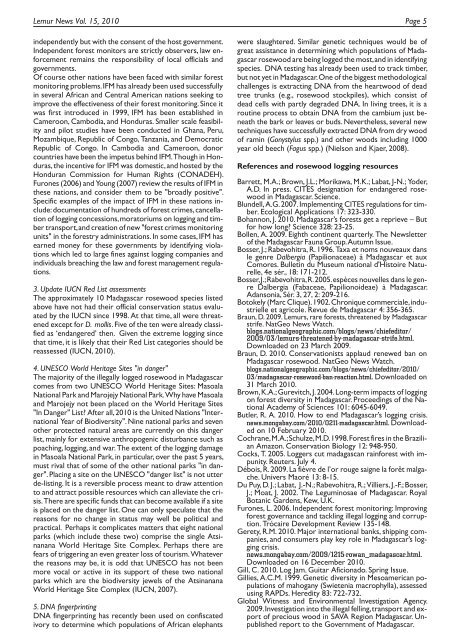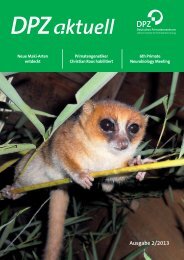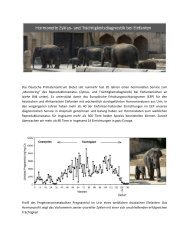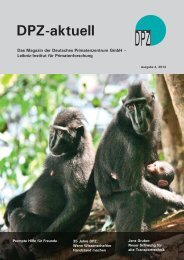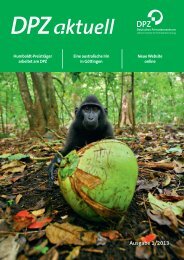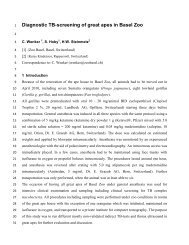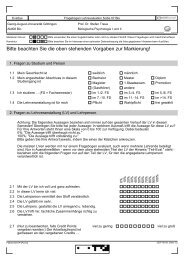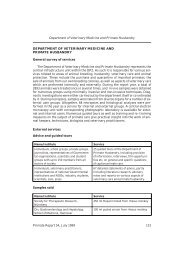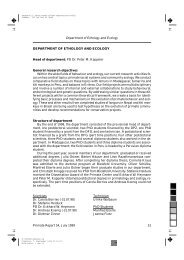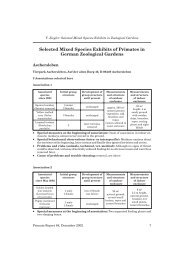Vol. 15 - Deutsches Primatenzentrum
Vol. 15 - Deutsches Primatenzentrum
Vol. 15 - Deutsches Primatenzentrum
Create successful ePaper yourself
Turn your PDF publications into a flip-book with our unique Google optimized e-Paper software.
Lemur News <strong>Vol</strong>. <strong>15</strong>, 2010 Page 5<br />
independently but with the consent of the host government.<br />
Independent forest monitors are strictly observers, law enforcement<br />
remains the responsibility of local officials and<br />
governments.<br />
Of course other nations have been faced with similar forest<br />
monitoring problems.IFM has already been used successfully<br />
in several African and Central American nations seeking to<br />
improve the effectiveness of their forest monitoring. Since it<br />
was first introduced in 1999, IFM has been established in<br />
Cameroon, Cambodia, and Honduras. Smaller scale feasibility<br />
and pilot studies have been conducted in Ghana, Peru,<br />
Mozambique, Republic of Congo, Tanzania, and Democratic<br />
Republic of Congo. In Cambodia and Cameroon, donor<br />
countries have been the impetus behind IFM.Though in Honduras,the<br />
incentive for IFM was domestic,and hosted by the<br />
Honduran Commission for Human Rights (CONADEH).<br />
Furones (2006) and Young (2007) review the results of IFM in<br />
these nations, and consider them to be "broadly positive".<br />
Specific examples of the impact of IFM in these nations include:documentation<br />
of hundreds of forest crimes,cancellation<br />
of logging concessions,moratoriums on logging and timber<br />
transport,and creation of new "forest crimes monitoring<br />
units" in the forestry administrations. In some cases,IFM has<br />
earned money for these governments by identifying violations<br />
which led to large fines against logging companies and<br />
individuals breaching the law and forest management regulations.<br />
3. Update IUCN Red List assessments<br />
The approximately 10 Madagascar rosewood species listed<br />
above have not had their official conservation status evaluated<br />
by the IUCN since 1998. At that time, all were threatened<br />
except for D. mollis.Five of the ten were already classified<br />
as ‘endangered’ then. Given the extreme logging since<br />
that time, it is likely that their Red List categories should be<br />
reassessed (IUCN, 2010).<br />
4. UNESCO World Heritage Sites "in danger"<br />
The majority of the illegally logged rosewood in Madagascar<br />
comes from two UNESCO World Heritage Sites: Masoala<br />
National Park and Marojejy National Park.Why have Masoala<br />
and Marojejy not been placed on the World Heritage Sites<br />
"In Danger" List? After all,2010 is the United Nations "International<br />
Year of Biodiversity". Nine national parks and seven<br />
other protected natural areas are currently on this danger<br />
list, mainly for extensive anthropogenic disturbance such as<br />
poaching, logging, and war. The extent of the logging damage<br />
in Masoala National Park, in particular, over the past 5 years,<br />
must rival that of some of the other national parks "in danger".<br />
Placing a site on the UNESCO "danger list" is not utter<br />
de-listing. It is a reversible process meant to draw attention<br />
to and attract possible resources which can alleviate the crisis.There<br />
are specific funds that can become available if a site<br />
is placed on the danger list. One can only speculate that the<br />
reasons for no change in status may well be political and<br />
practical. Perhaps it complicates matters that eight national<br />
parks (which include these two) comprise the single Atsinanana<br />
World Heritage Site Complex. Perhaps there are<br />
fears of triggering an even greater loss of tourism.Whatever<br />
the reasons may be, it is odd that UNESCO has not been<br />
more vocal or active in its support of these two national<br />
parks which are the biodiversity jewels of the Atsinanana<br />
World Heritage Site Complex (IUCN, 2007).<br />
5. DNA fingerprinting<br />
DNA fingerprinting has recently been used on confiscated<br />
ivory to determine which populations of African elephants<br />
were slaughtered. Similar genetic techniques would be of<br />
great assistance in determining which populations of Madagascar<br />
rosewood are being logged the most,and in identifying<br />
species. DNA testing has already been used to track timber,<br />
but not yet in Madagascar.One of the biggest methodological<br />
challenges is extracting DNA from the heartwood of dead<br />
tree trunks (e.g., rosewood stockpiles), which consist of<br />
dead cells with partly degraded DNA. In living trees, it is a<br />
routine process to obtain DNA from the cambium just beneath<br />
the bark or leaves or buds. Nevertheless, several new<br />
techniques have successfully extracted DNA from dry wood<br />
of ramin (Gonystylus spp.) and other woods including 1000<br />
year old beech (Fagus spp.) (Nielson and Kjaer, 2008).<br />
References and rosewood logging resources<br />
Barrett, M.A.; Brown, J.L.; Morikawa, M.K.; Labat, J-N.; Yoder,<br />
A.D. In press. CITES designation for endangered rosewood<br />
in Madagascar. Science.<br />
Blundell,A.G.2007.Implementing CITES regulations for timber.<br />
Ecological Applications 17: 323-330.<br />
Bohannon, J. 2010. Madagascar’s forests get a reprieve – But<br />
for how long? Science 328: 23-25.<br />
Bollen, A. 2009. Eighth continent quarterly. The Newsletter<br />
of the Madagascar Fauna Group.Autumn Issue.<br />
Bosser, J.; Rabevohitra, R. 1996. Taxa et noms nouveaux dans<br />
le genre Dalbergia (Papilionaceae) à Madagascar et aux<br />
Comores. Bulletin du Museum national d'Histoire Naturelle,<br />
4e sér., 18: 171-212.<br />
Bosser,J.;Rabevohitra,R.2005.espèces nouvelles dans le genre<br />
Dalbergia (Fabaceae, Papilionoideae) à Madagascar.<br />
Adansonia, Sér. 3, 27, 2: 209-216.<br />
Botokely (Marc Clique).1902.Chronique commerciale,industrielle<br />
et agricole. Revue de Madagascar 4: 356-365.<br />
Braun, D. 2009. Lemurs, rare forests, threatened by Madagascar<br />
strife. NatGeo News Watch.<br />
blogs.nationalgeographic.com/blogs/news/chiefeditor/<br />
2009/03/lemurs-threatened-by-madagascar-strife.html.<br />
Downloaded on 23 March 2009.<br />
Braun, D. 2010. Conservationists applaud renewed ban on<br />
Madagascar rosewood. NatGeo News Watch.<br />
blogs.nationalgeographic.com/blogs/news/chiefeditor/2010/<br />
03/madagascar-rosewood-ban-reaction.html. Downloaded on<br />
31 March 2010.<br />
Brown,K.A.;Gurevitch,J.2004.Long-term impacts of logging<br />
on forest diversity in Madagascar. Proceedings of the National<br />
Academy of Sciences 101: 6045-6049.<br />
Butler, R. A. 2010. How to end Madagascar’s logging crisis.<br />
news.mongabay.com/2010/0211-madagascar.html. Downloaded<br />
on 10 February 2010.<br />
Cochrane,M.A.;Schulze,M.D.1998.Forest fires in the Brazilian<br />
Amazon. Conservation Biology 12: 948-950.<br />
Cocks, T. 2005. Loggers cut madagascan rainforest with impunity.<br />
Reuters. July 4.<br />
Débois, R.2009. La fièvre de l’or rouge saigne la forêt malgache.<br />
Univers Maoré 13: 8-<strong>15</strong>.<br />
Du Puy, D. J.; Labat, J.-N.; Rabevohitra, R.;Villiers, J.-F.;Bosser,<br />
J.; Moat, J. 2002. The Leguminosae of Madagascar. Royal<br />
Botanic Gardens, Kew, U.K.<br />
Furones, L. 2006. Independent forest monitoring: Improving<br />
forest governance and tackling illegal logging and corruption.<br />
Trócaire Development Review 135-148.<br />
Gerety, R.M. 2010. Major international banks, shipping companies,<br />
and consumers play key role in Madagascar’s logging<br />
crisis.<br />
news.mongabay.com/2009/12<strong>15</strong>-rowan_madagascar.html.<br />
Downloaded on 16 December 2010.<br />
Gill, C. 2010. Log Jam. Guitar Aficionado. Spring Issue.<br />
Gillies, A.C.M. 1999. Genetic diversity in Mesoamerican populations<br />
of mahogany (Swietenia macrophylla), assessed<br />
using RAPDs. Heredity 83: 722-732.<br />
Global Witness and Environmental Investigation Agency.<br />
2009.Investigation into the illegal felling,transport and export<br />
of precious wood in SAVA Region Madagascar. Unpublished<br />
report to the Government of Madagascar.


